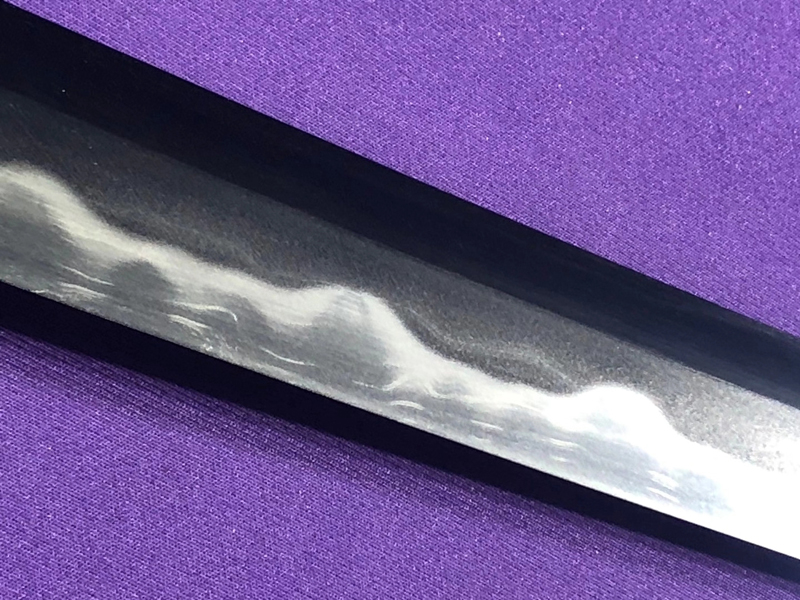By lyuesword | 29 December 2020 | 0 Comments
How Differential Heat Treatment Creates the Hamon on Swords
How Differential Heat Treatment Creates the Hamon on Swords
When examining authentic traditional Japanese swords, you'll probably discovering various lines, shapes, patterns or geometric figures running the length of the blade. Known as a tempering line or "hamon," it's a defining characteristic of traditional Japanese swords. From the katana and wakizashi to the tanto and tachi, countless Japanese swords feature a hamon, which is the result of the differential heat treatment. So, how does differential heat treatment create a sword's hamon exactly?
Differential Heat Treatment: The Basics
To understand how a sword's hamon is created, you must first look at differential heat treatment. During feudal Japan, bladesmiths discovered that by heating and cooling the spine and edge of a sword's blade at different rates, they could achieve more desirable results. Bladesmiths would first heat up the entire blade, and then they would apply a thick layer of clay to the spine. Next, bladesmiths would quench the entire blade in water or oil. With the spine covered in a thick layer of clay, however, it cools more slowly than the edge, resulting in a strong edge and flexible spine.

The Formation of the Hamon
When differential heat treatment is performed on a sword, it changes the sword's physical characteristics. As the edge becomes stronger, it creates visible lines. Known as a hamon, it's essentially an outline of the hardened area of the blade.
Technically speaking, the hamon is created where the harder martensitic steel of the sword meets the softer and more flexible pearlitic steel. Traditional Japanese swords, after undergoing differential heat treatment, have two types of steel: martensitic steel and pearlitic steel. The former is a harder type of high-carbon steel that's found lengthwise on the blade's edge, whereas the latter is a softer type of high-carbon steel that's found lengthwise on the sword's spine. The area where these two types of steel meet has visual lines known as a hamon.

Origins of Hamons in Traditional Japanese Swords
It's unknown who was the first bladesmith to create and use hamons in traditional Japanese swords. However, there's an old legend stating that Japanese bladesmith Amakuni Yasutsuna was responsible for creating this technique.
The legend states that the Japanese emperor was returning to his kingdom when Yasutsuna discovered that half of the swords in the emperor's weaponry were broken. As a result, Yasutsuna began experimenting with new bladesmithing techniques to try and create stronger swords that were less likely to break. This led Yasutsuna to inventing differential heat treatment around the eighth century. Whether this legend is true remains unknown, but most historians agree that differential heat treatment -- along with hamons -- were invented sometime during Japan's feudal era.
Want a unique sword? Feel free to contact us:
Email: lyuesword@hotmail.com
Website: www.lyuesword.com
Custom Sword Page: www.lyuesword.com/Custom-Sword/customization-options/Create-Your-Own-Swords
When examining authentic traditional Japanese swords, you'll probably discovering various lines, shapes, patterns or geometric figures running the length of the blade. Known as a tempering line or "hamon," it's a defining characteristic of traditional Japanese swords. From the katana and wakizashi to the tanto and tachi, countless Japanese swords feature a hamon, which is the result of the differential heat treatment. So, how does differential heat treatment create a sword's hamon exactly?
Differential Heat Treatment: The Basics
To understand how a sword's hamon is created, you must first look at differential heat treatment. During feudal Japan, bladesmiths discovered that by heating and cooling the spine and edge of a sword's blade at different rates, they could achieve more desirable results. Bladesmiths would first heat up the entire blade, and then they would apply a thick layer of clay to the spine. Next, bladesmiths would quench the entire blade in water or oil. With the spine covered in a thick layer of clay, however, it cools more slowly than the edge, resulting in a strong edge and flexible spine.

The Formation of the Hamon
When differential heat treatment is performed on a sword, it changes the sword's physical characteristics. As the edge becomes stronger, it creates visible lines. Known as a hamon, it's essentially an outline of the hardened area of the blade.
Technically speaking, the hamon is created where the harder martensitic steel of the sword meets the softer and more flexible pearlitic steel. Traditional Japanese swords, after undergoing differential heat treatment, have two types of steel: martensitic steel and pearlitic steel. The former is a harder type of high-carbon steel that's found lengthwise on the blade's edge, whereas the latter is a softer type of high-carbon steel that's found lengthwise on the sword's spine. The area where these two types of steel meet has visual lines known as a hamon.

Origins of Hamons in Traditional Japanese Swords
It's unknown who was the first bladesmith to create and use hamons in traditional Japanese swords. However, there's an old legend stating that Japanese bladesmith Amakuni Yasutsuna was responsible for creating this technique.
The legend states that the Japanese emperor was returning to his kingdom when Yasutsuna discovered that half of the swords in the emperor's weaponry were broken. As a result, Yasutsuna began experimenting with new bladesmithing techniques to try and create stronger swords that were less likely to break. This led Yasutsuna to inventing differential heat treatment around the eighth century. Whether this legend is true remains unknown, but most historians agree that differential heat treatment -- along with hamons -- were invented sometime during Japan's feudal era.
Want a unique sword? Feel free to contact us:
Email: lyuesword@hotmail.com
Website: www.lyuesword.com
Custom Sword Page: www.lyuesword.com/Custom-Sword/customization-options/Create-Your-Own-Swords
Leave a Reply
Your email address will not be published.Required fields are marked. *